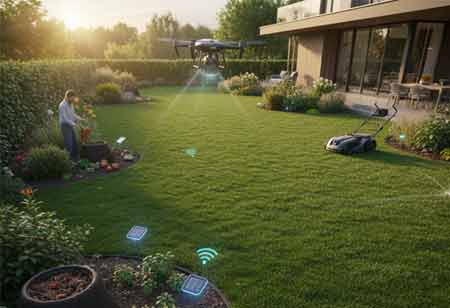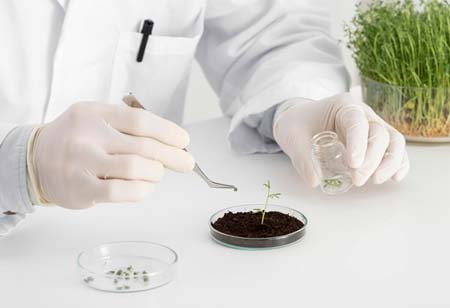Thank you for Subscribing to Agri Business Review Weekly Brief
Agricultural Machine Learning Software: Driving Climate-Smart Transformation Across Global Farming Systems
Climate-Smart Agriculture, powered by ML, enhances productivity and resilience to climate change while optimizing resource use and promoting sustainable farming practices.

By
Agri Business Review | Friday, October 31, 2025
Stay ahead of the industry with exclusive feature stories on the top companies, expert insights and the latest news delivered straight to your inbox. Subscribe today.
The global agricultural landscape faces the monumental responsibility of feeding a burgeoning world population while confronting the escalating realities of a changing climate. In this complex arena, a new paradigm is taking root: Climate-Smart Agriculture (CSA). This approach is built sustainably, increasing agricultural productivity and incomes, adapting to and building resilience against climate change, and reducing or eliminating greenhouse gas emissions where possible. Propelling this transformative shift from theory to practice is a powerful digital catalyst: Machine Learning (ML). The fusion of advanced data analytics with agronomy is forging a new frontier, recasting farming from a practice of tradition and intuition to one of precision, prediction, and proactive management.
In agriculture, ML offers extraordinary potential to comprehend and manage the inherent variability of natural systems. The vast influx of data generated from satellites, drones, and on-field IoT sensors serves as the raw material. At the same time, ML algorithms act as the analytical engines that transform this data into actionable intelligence—fundamentally revolutionizing farm-level operations.
Transforming Farm Operations: Hyper-Precision and Pest Management
Hyper-Precision farming marks a departure from traditional uniform field management toward a highly granular, data-driven approach. ML models lie at the core of this transformation, integrating diverse data layers—including soil nutrient composition, topography, historical yield records, and real-time moisture data — to divide a single field into numerous micro-zones. Each micro-zone then receives tailored input prescriptions—optimizing seeding density, fertilizer application, and irrigation volumes down to the square meter.
Computer vision, a subset of ML, also enables automated systems to differentiate between crops and weeds or detect early signs of pest infestation and disease. This facilitates highly targeted interventions, such as micro-dosing herbicides or pesticides, thereby enhancing input efficiency and supporting the overall health of the farm ecosystem.
Predictive Power: Yield Forecasting and Supply Chain Resilience
Advanced yield forecasting and market stability have long been challenges in agriculture due to the unpredictable effects of weather and other environmental factors. ML is introducing an unprecedented degree of accuracy and foresight into this process. By leveraging extensive historical datasets encompassing decades of weather patterns, crop genetics, soil profiles, and agronomic practices, ML models can produce reliable yield forecasts. As the growing season advances, these predictions are refined using real-time satellite imagery that captures vegetation density and ground-based sensor data tracking plant health. This predictive capacity extends beyond the individual farm, providing valuable insights for regional and national food security initiatives, stabilizing commodity markets, and enhancing logistics and supply chain management to create a more efficient farm-to-fork ecosystem.
Driving Environmental Stewardship: Soil Health and Water Efficiency
Enhancing soil health and carbon sequestration represents another frontier where ML is making significant contributions. The soil serves as both a vital carbon sink and the foundation of agricultural productivity, making its preservation central to Climate-Smart Agriculture. ML algorithms can synthesize soil sample data with satellite-derived remote sensing information to generate high-resolution maps of soil organic carbon levels across large geographic areas. This facilitates the precise implementation of regenerative practices such as cover cropping, no-till farming, and compost application. ML models can also predict the long-term impacts of these practices on carbon sequestration rates and soil fertility, fostering a data-guided, sustainable cycle that yields both environmental and agronomic benefits.
Intelligent water management is emerging as a cornerstone of sustainable agriculture. As water scarcity intensifies globally, ML is playing a pivotal role in optimizing its use. Predictive analytics are now being integrated into advanced irrigation systems that anticipate, rather than merely react to, a crop’s water requirements. By analyzing data from soil moisture sensors, localized weather forecasts, and plant evapotranspiration models, ML algorithms determine the optimal timing and precise volume of water needed. This prevents both underwatering, which can stress crops, and overwatering, which leads to nutrient leaching and resource waste. The outcome is a system that maximizes productivity per unit of water—often referred to as “crop per drop”—and enhances resilience in water-stressed agricultural regions.
ML is unlocked by its symbiotic relationship with a suite of other advanced technologies that form the sensory network of the modern farm. The Internet of Things (IoT) provides a continuous stream of ground-truth data from in-field sensors that measure everything from soil pH to ambient humidity. Drones and satellites equipped with multispectral and hyperspectral cameras offer a bird's-eye view, capturing data on plant health, water stress, and nutrient deficiencies across entire fields at a resolution unimaginable just a decade ago. ML serves as the central intelligence hub —the "brain" that synthesizes these disparate data streams. It transforms petabytes of raw data from this interconnected ecosystem into a coherent, dynamic picture of the farm, enabling holistic and informed decision-making.
The integration of ML into Climate-Smart agriculture is a fundamental re-imagining of how humanity will sustainably cultivate its future. The future farm will be a largely autonomous operation, where fleets of smart machinery, guided by real-time ML analytics, execute tasks with unparalleled efficiency day and night. This intelligent, data-driven approach is our most promising pathway to achieving the three pillars of CSA: boosting productivity to ensure global food security, fortifying our agricultural systems against climatic volatility, and transforming farms into cornerstones of environmental stewardship. ML is the key that unlocks this potential, seeding the ground for a resilient, productive, and sustainable agricultural future.





